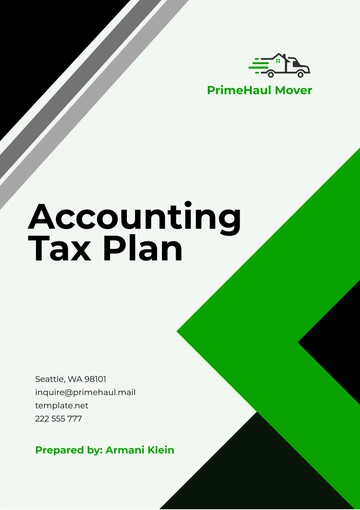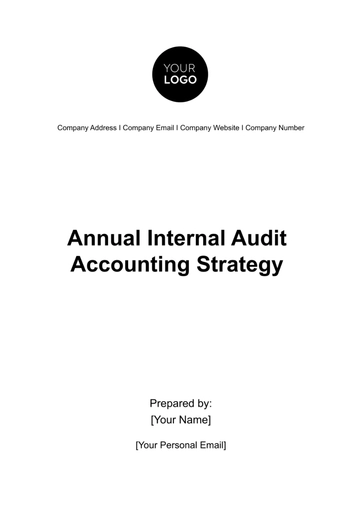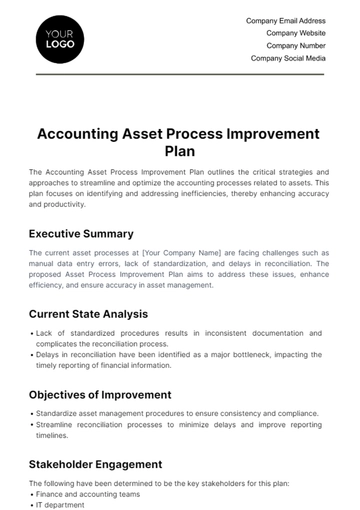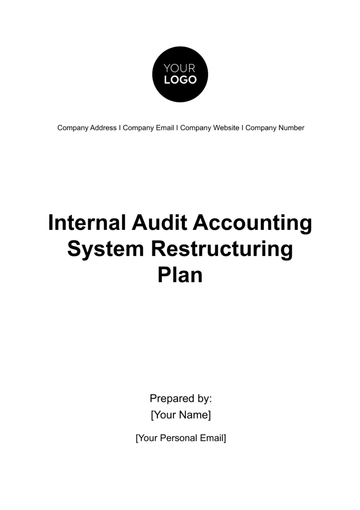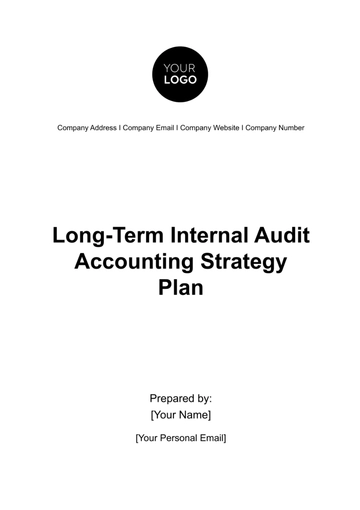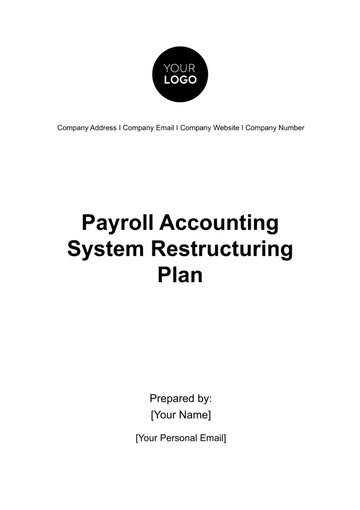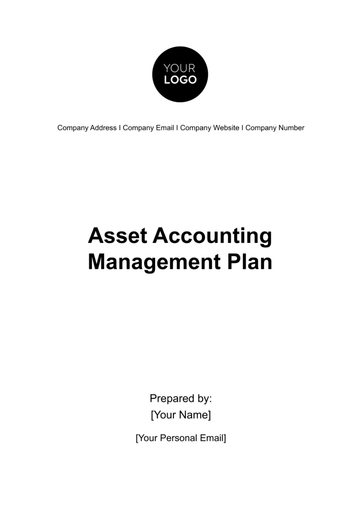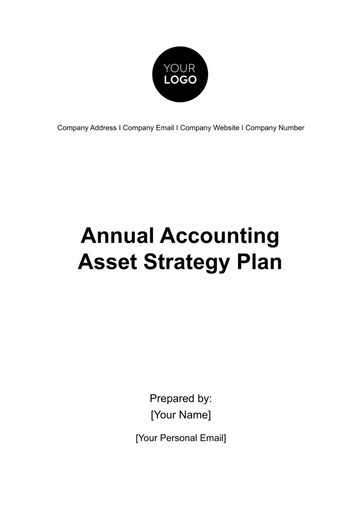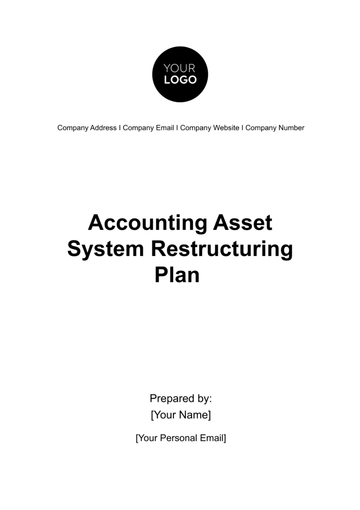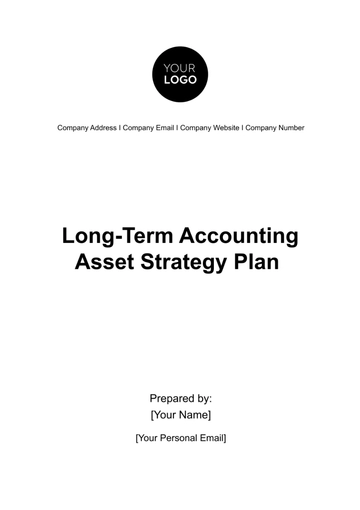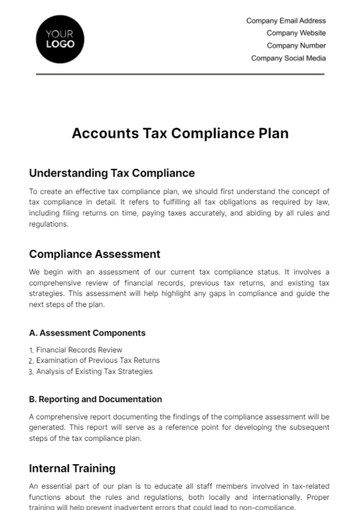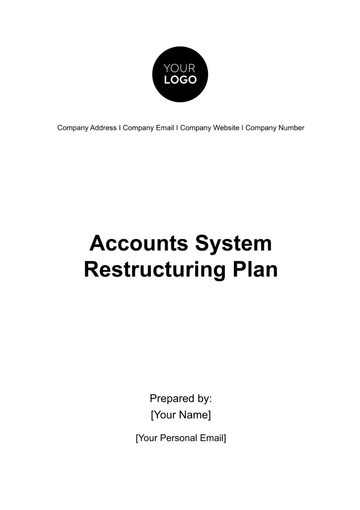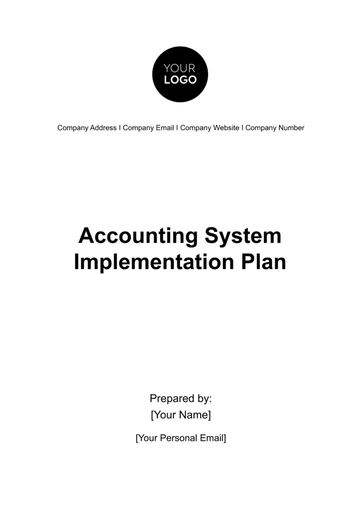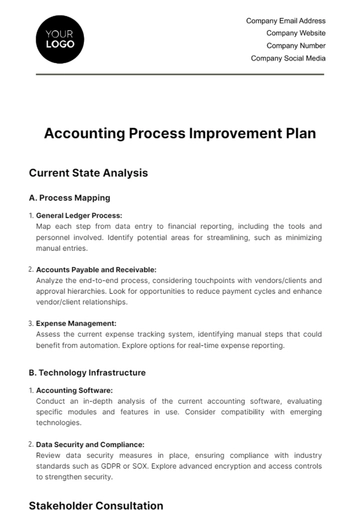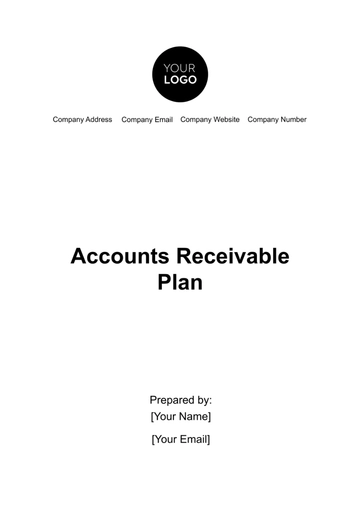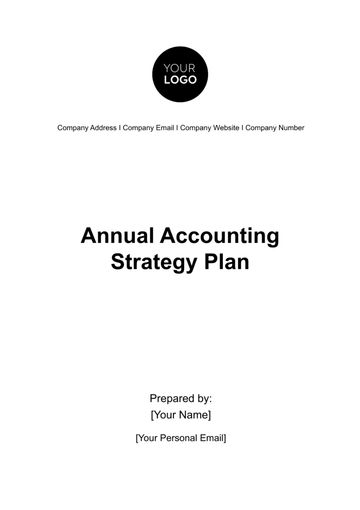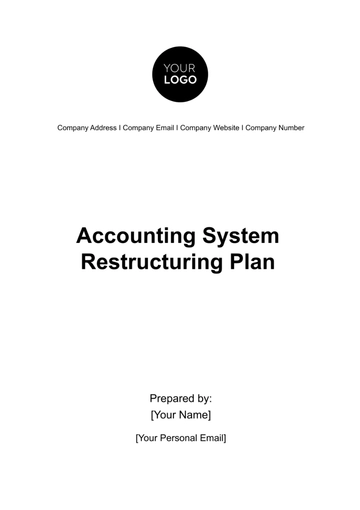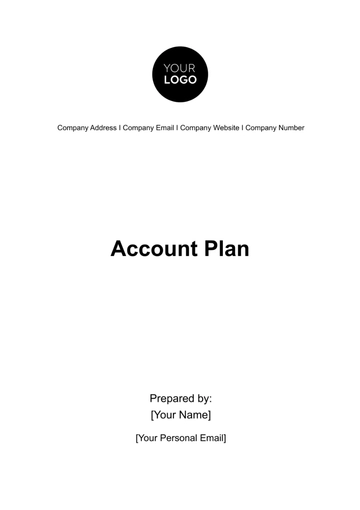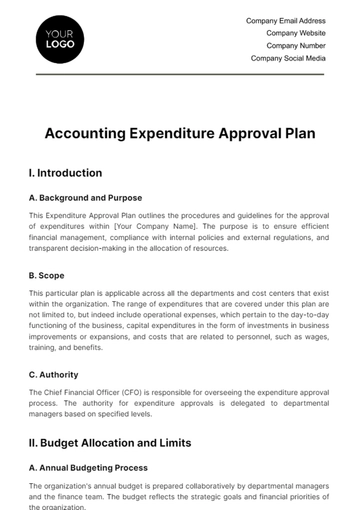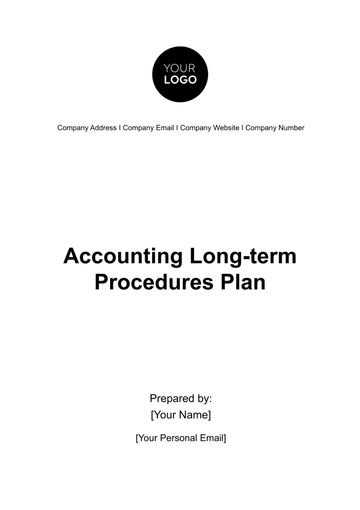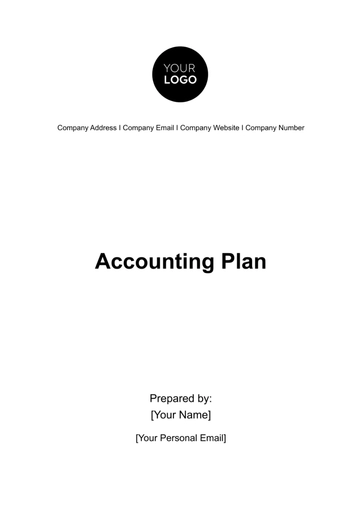Free Annual Accounting Strategy Plan
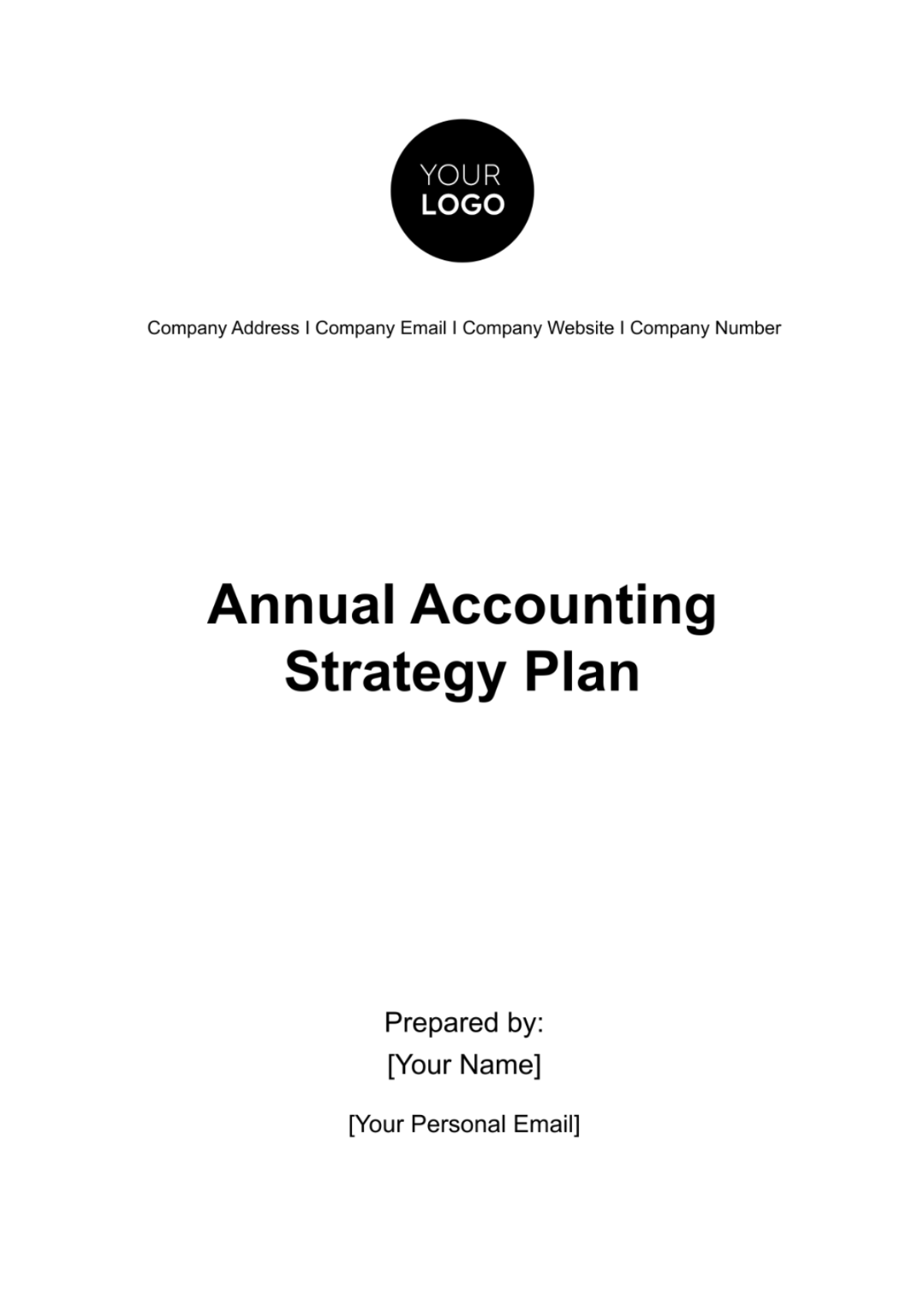
I. Executive Summary
Overview
The fiscal year [Year] marked a period of sustained growth and innovation for our organization. As we look ahead to [Year], our Annual Accounting Strategy Plan focuses on reinforcing financial stability, embracing technological advancements, and aligning financial goals with our strategic vision.
Key Achievements ([Year])
Achieved a [00]% year-over-year increase in revenue.
Successfully implemented cost optimization measures, resulting in a [00]% reduction in operational expenses.
Maintained a robust liquidity position, ensuring the organization's resilience in dynamic market conditions.
Financial Goals ([Year])
Targeting a [00]% increase in overall revenue.
Pursuing a sustainable profit margin of [00]%.
Allocating resources for strategic investments in renewable energy projects.
II. Organizational Overview
Mission and Vision
Our mission is to lead the global business landscape by driving sustainable growth through innovation and responsible business practices. We are committed to creating value for our stakeholders while minimizing our environmental footprint and contributing positively to the communities we serve. Our vision is to be recognized as a trailblazer in corporate responsibility, setting new standards for ethical business conduct and environmental stewardship.
Industry Trends
In the rapidly evolving landscape of [Year], our organization anticipates and embraces key industry trends. We foresee an increased emphasis on sustainability practices, with a shift towards circular economies and a growing demand for environmentally conscious products and services. Furthermore, advancements in artificial intelligence and digital technologies are expected to reshape the way we operate and interact within our industry.
Strategic Priorities
Our strategic priorities for [Year] are anchored in three key pillars. First, we commit to leading in sustainability and environmental responsibility, integrating these principles into every facet of our operations. Second, we will be at the forefront of technological innovation, leveraging artificial intelligence and cutting-edge digital tools to enhance efficiency and create value. Lastly, we aim to expand our global footprint by strategically entering emerging markets, fostering diversity, and building lasting partnerships to strengthen our position in the industry.
III. Financial Goals and Objectives
Targets ([Year])
Metric | Target |
|---|---|
Revenue Growth | 12% |
Profit Margin | |
Return on Investment (ROI) |
Cost Reduction Objectives
Implement efficiency measures to achieve a 10% reduction in operational costs.
IV. Budgeting and Forecasting
Annual Budget ([Year])
Category | Budget (in millions) |
|---|---|
Revenue | |
Operating Expenses | |
Capital Expenditures |
Quarterly Financial Forecasts
Quarter | Revenue Forecast (in millions) | Expense Forecast (in millions) |
|---|---|---|
Q1 | $600 | $450 |
Assumptions
Economic stability and moderate inflation rates.
Successful implementation of cost reduction initiatives.
V. Risk Management
Identified Risks
In the dynamic landscape of [Year], our risk management strategy acknowledges potential challenges. Market fluctuations, including volatility in commodity prices, remain a significant concern. Regulatory changes, particularly in response to evolving environmental standards, pose potential impacts. Additionally, the persistent threat of cybersecurity breaches necessitates ongoing vigilance to protect sensitive financial information.
Mitigation Strategies
To address these risks, we employ a multi-faceted approach. Diversification of revenue streams helps mitigate the impact of market fluctuations. Regular compliance audits and proactive engagement with regulatory bodies ensure adaptability to evolving standards. Our investment in advanced cybersecurity measures, including AI-driven threat detection, aims to safeguard our organization's sensitive data and maintain the trust of our stakeholders.
Contingency Plans
Our contingency plans include maintaining a financial reserve to navigate economic downturns, ensuring the flexibility to reallocate resources strategically. Scenario planning exercises are regularly conducted to assess potential market disruptions, allowing for swift and adaptive responses to unforeseen challenges.
VI. Compliance
Accounting Standards
As of [Year], our commitment to transparency and accountability remains unwavering. We adhere rigorously to the latest International Financial Reporting Standards (IFRS), ensuring the accuracy and consistency of our financial reporting. Regular training programs for our accounting team are conducted to keep them abreast of any updates or modifications to these standards.
Tax Compliance
In an era of global interconnectedness, we maintain meticulous adherence to global tax regulations and reporting requirements. Collaborative efforts with tax experts and engagement in ongoing dialogues with tax authorities help us stay ahead of changes, ensuring compliance with evolving tax standards.
Changes in Regulations
Given the fast-paced nature of regulatory changes, our proactive stance involves continuous monitoring and analysis of global financial regulations. A dedicated regulatory affairs team is tasked with interpreting and implementing adjustments to ensure our organization remains at the forefront of compliance in the ever-evolving regulatory landscape.
VII. Investment and Capital Expenditure Planning
Strategic Investments
For the year [Year], our investment strategy revolves around fostering innovation in sustainable technologies. We are allocating $[000] million for research and development initiatives focused on reducing our ecological footprint. These strategic investments align with our commitment to environmental stewardship while driving long-term value for our organization and stakeholders.
Capital Expenditure Criteria
Our capital expenditure decisions prioritize projects that exhibit a tangible impact on our sustainability goals, demonstrate a high potential for innovation, and offer a favorable return on investment. The criteria encompass considerations for long-term viability, social responsibility, and alignment with our overall strategic objectives.
VIII. Cash Flow Management
Working Capital Strategies
To optimize cash flow, we implement working capital management strategies that strike a balance between maintaining liquidity and efficiently utilizing resources. Streamlined processes for inventory management, accounts receivable, and accounts payable contribute to a resilient and agile financial position.
Accounts Receivable and Payable
Enhanced monitoring and management of accounts receivable and payable are integral components of our cash flow management strategy. Utilizing predictive analytics, we aim to improve payment cycles, reduce outstanding balances, and strengthen relationships with suppliers and customers.
Cash Flow Improvement Initiatives
Our commitment to innovation extends to financial processes. The introduction of digital payment solutions and automation not only enhances efficiency but also contributes to a more seamless and transparent cash flow management system.
IX. Performance Measurement and Reporting
Key Performance Indicators (KPIs)
In [Year], our KPIs are carefully selected to reflect our commitment to sustainability and financial performance. Metrics include the Revenue Growth Rate, EBITDA Margin, and a Sustainability Index, providing a comprehensive view of our organizational success and impact on environmental and social fronts.
Reporting Mechanisms
To ensure transparency and accountability, we communicate our financial and sustainability performance through various channels. Monthly financial statements, quarterly performance reviews, and annual sustainability reports are integral components of our reporting mechanisms, fostering trust among stakeholders.
Monitoring and Analysis
Regular monitoring and analysis against established benchmarks enable us to make informed decisions. The feedback loop created through ongoing assessments ensures that we adapt swiftly to changing circumstances, continually refining our strategies for optimal performance.
X. Technology and Process Improvements
Technology Integration
Our commitment to technological advancement includes significant investments in AI-driven analytics. This technology integration enhances our financial forecasting capabilities, providing real-time insights that guide strategic decision-making and position us at the forefront of industry innovation.
Process Enhancements
Continuous improvement initiatives extend to our financial workflows. By leveraging emerging technologies, we streamline processes to reduce manual efforts, enhance accuracy, and ensure that our financial operations remain agile and responsive to changing business dynamics.
XI. Training and Development
Staff Training Programs
In [Year], our dedication to knowledge advancement includes ongoing training programs for our finance and accounting staff. These programs cover emerging accounting standards, technological advancements, and evolving industry best practices to empower our team with the latest skills and expertise.
Professional Development
To foster a culture of continuous improvement, we encourage our team members to pursue professional certifications and engage in regular professional development opportunities. This commitment to skill-building ensures that our finance team remains adaptive and well-equipped to meet the challenges of a dynamic business environment.
XII. Contingency Planning
Economic Downturns
Our contingency planning for economic downturns involves maintaining flexible resource allocation strategies and a robust financial reserve. By regularly stress-testing our financial models, we ensure readiness to navigate uncertainties and capitalize on strategic opportunities that may arise during challenging economic periods.
Market Disruptions
In an era marked by rapid technological advancements, our agile response strategies are designed to adapt swiftly to market disruptions. Scenario planning exercises, coupled with a proactive stance toward innovation, position us to capitalize on emerging trends and navigate uncertainties with resilience.
XIII. Sustainability and ESG Goals
ESG Integration
Our commitment to Environmental, Social, and Governance (ESG) principles is ingrained in our financial decision-making processes. By integrating ESG considerations, we ensure that our operations align with the highest standards of ethical conduct and contribute positively to the well-being of our planet and communities.
Sustainability Goals
In [Year], our sustainability goals include achieving carbon neutrality by [Year] and increasing the use of sustainable materials in production processes by [00]. These ambitious targets underscore our dedication to environmental responsibility and fostering a sustainable future.
XIV. Stakeholder Communication
Shareholder Communication
Regular communication with shareholders is a cornerstone of our transparency efforts. Quarterly earnings calls and annual shareholder meetings provide platforms for transparent discussions, ensuring that our shareholders are informed about our financial performance and strategic direction.
Investor Relations
Engagement with investors extends beyond mandatory reporting. Conferences, forums, and collaborative initiatives foster a strong relationship with investors, providing them with deeper insights into our long-term vision, sustainability efforts, and commitment to generating value over time.
Stakeholder Collaboration
Collaboration with NGOs and active community involvement are central to our stakeholder engagement strategy. By understanding and addressing the diverse needs of our stakeholders, we strengthen relationships, build trust, and contribute positively to the communities in which we operate.
XV. Approval and Implementation
Presentation
The Annual Accounting Strategy Plan for [Year] will be presented to the executive leadership team, providing a comprehensive overview of our financial strategies and initiatives for the upcoming year.
Discussion and Feedback
An open dialogue will be encouraged during the presentation, allowing for constructive feedback and suggestions from the executive leadership team. This collaborative approach ensures that diverse perspectives are considered and improvements can be made where necessary.
Formal Approval
Following the presentation and discussion, the Annual Accounting Strategy Plan will undergo formal approval. Once approved, the plan will be communicated to all relevant stakeholders, signaling the organization's commitment to the outlined strategies and goals for the fiscal year [Year].
- 100% Customizable, free editor
- Access 1 Million+ Templates, photo’s & graphics
- Download or share as a template
- Click and replace photos, graphics, text, backgrounds
- Resize, crop, AI write & more
- Access advanced editor
Elevate your financial foresight with the Annual Accounting Strategy Plan Template from Template.net. This editable and customizable template, powered by an intuitive AI Editor Tool, simplifies strategic planning. Crafted for precision, it seamlessly blends flexibility and innovation, ensuring your financial goals align seamlessly with your organization's vision. Take charge of your fiscal future effortlessly.
You may also like
- Finance Plan
- Construction Plan
- Sales Plan
- Development Plan
- Career Plan
- Budget Plan
- HR Plan
- Education Plan
- Transition Plan
- Work Plan
- Training Plan
- Communication Plan
- Operation Plan
- Health And Safety Plan
- Strategy Plan
- Professional Development Plan
- Advertising Plan
- Risk Management Plan
- Restaurant Plan
- School Plan
- Nursing Home Patient Care Plan
- Nursing Care Plan
- Plan Event
- Startup Plan
- Social Media Plan
- Staffing Plan
- Annual Plan
- Content Plan
- Payment Plan
- Implementation Plan
- Hotel Plan
- Workout Plan
- Accounting Plan
- Campaign Plan
- Essay Plan
- 30 60 90 Day Plan
- Research Plan
- Recruitment Plan
- 90 Day Plan
- Quarterly Plan
- Emergency Plan
- 5 Year Plan
- Gym Plan
- Personal Plan
- IT and Software Plan
- Treatment Plan
- Real Estate Plan
- Law Firm Plan
- Healthcare Plan
- Improvement Plan
- Media Plan
- 5 Year Business Plan
- Learning Plan
- Marketing Campaign Plan
- Travel Agency Plan
- Cleaning Services Plan
- Interior Design Plan
- Performance Plan
- PR Plan
- Birth Plan
- Life Plan
- SEO Plan
- Disaster Recovery Plan
- Continuity Plan
- Launch Plan
- Legal Plan
- Behavior Plan
- Performance Improvement Plan
- Salon Plan
- Security Plan
- Security Management Plan
- Employee Development Plan
- Quality Plan
- Service Improvement Plan
- Growth Plan
- Incident Response Plan
- Basketball Plan
- Emergency Action Plan
- Product Launch Plan
- Spa Plan
- Employee Training Plan
- Data Analysis Plan
- Employee Action Plan
- Territory Plan
- Audit Plan
- Classroom Plan
- Activity Plan
- Parenting Plan
- Care Plan
- Project Execution Plan
- Exercise Plan
- Internship Plan
- Software Development Plan
- Continuous Improvement Plan
- Leave Plan
- 90 Day Sales Plan
- Advertising Agency Plan
- Employee Transition Plan
- Smart Action Plan
- Workplace Safety Plan
- Behavior Change Plan
- Contingency Plan
- Continuity of Operations Plan
- Health Plan
- Quality Control Plan
- Self Plan
- Sports Development Plan
- Change Management Plan
- Ecommerce Plan
- Personal Financial Plan
- Process Improvement Plan
- 30-60-90 Day Sales Plan
- Crisis Management Plan
- Engagement Plan
- Execution Plan
- Pandemic Plan
- Quality Assurance Plan
- Service Continuity Plan
- Agile Project Plan
- Fundraising Plan
- Job Transition Plan
- Asset Maintenance Plan
- Maintenance Plan
- Software Test Plan
- Staff Training and Development Plan
- 3 Year Plan
- Brand Activation Plan
- Release Plan
- Resource Plan
- Risk Mitigation Plan
- Teacher Plan
- 30 60 90 Day Plan for New Manager
- Food Safety Plan
- Food Truck Plan
- Hiring Plan
- Quality Management Plan
- Wellness Plan
- Behavior Intervention Plan
- Bonus Plan
- Investment Plan
- Maternity Leave Plan
- Pandemic Response Plan
- Succession Planning
- Coaching Plan
- Configuration Management Plan
- Remote Work Plan
- Self Care Plan
- Teaching Plan
- 100-Day Plan
- HACCP Plan
- Student Plan
- Sustainability Plan
- 30 60 90 Day Plan for Interview
- Access Plan
- Site Specific Safety Plan
